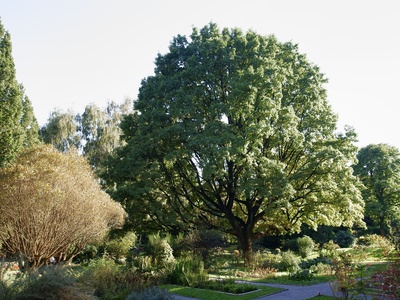
Get a quick no obligation quote It’s free and will only take a jiffy!
When is the Best Time to Prune a Sessile Oak Tree?
The sessile oak tree is a UK native species of oak identified by its stalk-free acorns. The naturally broad and open canopy allows wildflowers to thrive beneath it, so it is important to keep the crown in check. But when to prune a sessile oak for best effect, and what to look out for when doing so?
The sessile oak, Quercus petraea, is a UK native deciduous tree with a broad, rounded crown. The tree is known as ‘sessile’ because its acorns grow directly on the outer twigs rather than on stalks as they do on the English oak tree.
Sessile oak trees grow up to 40 metres in height, forming an expansive crown with a strong supporting network of branches. The canopy is open, which allows light to get through to the ground below which means wildflowers like primroses and bluebells can thrive beneath. Sessile oak trees will often live to a grand age of 700 years and are commonly found in parks and woodland.
Why prune a sessile oak tree?
Sessile oak branches are fairly straight and radiate outwards, and the crown appears open when in leaf. The light penetration to the floor below the tree is of key importance to the wild flowers that grow beneath. It is therefore important to maintain this open structure with light pruning as and when required.
Any damaged branches or those that have started to decay must be regularly tidied up to keep the tree looking its best and in good health.
When is the best time to prune a sessile oak?
The best time to prune a sessile oak tree is during the late winter or early spring months.
It is essential to remove diseased, decaying or damaged branches and when they are spotted. Any time of year is fine for this providing appropriate safety measures are employed bearing in mind the size of this tree.
Important things to check for when you prune a sessile oak
The sessile oak is susceptible to aphids including greenfly, blackfly and plant lice. Aphids suck sap and can pass on plant viruses, leaving a tree listless and distorted. Viruses can cause all sorts of problems making it essential to take professional advice whenever an infestation is identified.
The leaf mining moth can also affect the sessile oak. Look out for brownish white blotches or uneven linear mines within the leaves. Whilst there is no control for oak leaf-miners, the sessile oak is thankfully able to tolerate any damage caused fairly well and will usually grow even when there is a large infestation. Once the new leaves start to take over from the affected foliage, the general appearance of the tree will start to see improvement.
Oak gall wasps can also be a problem for the sessile oak which is a host plant for over 30 species. The larvae of these wasps induce abnormal growths on the tree.
Sessile oak trees may also be affected by oak decline including acute oak decline and chronic oak dieback. Here’s what to look out for:
Chronic oak decline:
- Deterioration of the crown over several years
- Paler and smaller leaves over time
- Dieback of twigs then smaller branches
- Dieback of larger branches
Sometimes the tree will die when affected by chronic oak decline, however a lot of the time it will partially recover or stabilise. Trees in recovery will show a healthy lower crown but with large dead branches in the upper crown projecting above it. These look like antlers, creating what’s known as the ‘staghead’ effect.
Acute oak decline:
- A dark fluid weeping from cracks in the trunk
- Multiple bleeding patches right up the height of the tree
The tree may die within four to five years. However, deterioration of the crown may not become obvious until just before the death of the tree.
Caterpillars and powdery mildew are also known problems for the sessile oak.
Tree Preservation Orders
Trees of notable interest are often protected by a Tree Preservation Order (TPO). Where there is a TPO in place, the level of pruning allowed for the protected tree will be restricted and you will need to obtain permission to undertake out works of any kind. You’ll need to contact the arboriculture department of your local council to check the TPO register before starting any work. If permission is needed you should be aware that this may take up to eight weeks to be granted. Furthermore, where a tree is located in a conservation area, you will need permission before going ahead with works of any kind.
The importance of expertise in sessile oak pruning
The sessile oak is a magnificent tree. Keeping it nice and tidy and checking regularly for infestations and diseases is vital. The best way to do this is to engage a professional tree surgeon.
When choosing a tree surgeon, always carry out due diligence. Make sure you look carefully at their references and certificates. Also, if possible, select a tree surgeon with Trading Standards and local authority approval. This will guarantee value and peace of mind.
If you have a sessile oak tree that needs pruning, dead-wooding or professional attention, why not contact the specialists at T.H. Tree Services? As fully qualified, locally renowned and highly experienced Trading Standards and local authority approved tree surgeons, we are in the best position to provide specialist knowledge in all aspects of sessile oak pruning and care. For a free, no-obligation quotation, call 01268 642814 or get in touch here.
Had a fallen tree in the early hours of Monday morning, called for quote and the team had it cleared on the same day. Really good communication when the lads were onsite and did a great job. Lots of pride in their work shown with the thorough clear up. Would thoroughly recommend.
Thank you Stuart for your kind review. We were glad to be able to help you with your fallen tree. If there's anything else you need in the future, please don't hesitate to get in touch.








